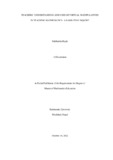
Please use this identifier to cite or link to this item:
https://hdl.handle.net/20.500.14301/147| Title: | TEACHERS’ UNDERSTANDING AND USES OF VIRTUAL MANIPULATIVES IN TEACHING MATHEMATICS: A NARRATIVE INQUIRY |
| Authors: | Rajak, Siddhartha |
| Citation: | Rajak,S.(2022)'Teachers’ understanding and uses of virtual manipulatives in teaching mathematics: A narrative inquiry. |
| Issue Date: | 16-Oct-2022 |
| Publisher: | Kathmandu University School of Education |
| School: | SOED |
| Department: | DOSE |
| Level: | Masters |
| Program: | Master of Education in Mathematics Education |
| Abstract: | By the end of the second decade of the 21st century, COVID-19 had rocked the whole world and affected most sectors across the globe. In these trying times, the education sector could not remain unscathed as the physical distancing was the only preventive measure that all were applying. The drumbeats of the COVID-19 pandemic escorted education into the virtual mode as physical distancing was imposed by governments of almost all the countries. In the context of Nepal, the majority of schools were implementing virtual teaching and learning for the very first time due to which the need to know the understanding of mathematics teachers on virtual manipulatives was essential. From the eyes of a mathematics teacher, I wanted to know the extent of mathematics teachers’ understanding when they opted to teach mathematics through the use of virtual manipulatives. In order to know about the contemporary practices of virtual mathematics teaching in Nepal, I have chosen narrative inquiry. In this research, I have explored the understanding of different mathematics teachers on their use of the virtual manipulatives using narrative research design. ii The purpose of my research is to explore teachers’ understanding and uses of virtual manipulatives in teaching mathematics by probing deep into the teachers’ environment, reliving the teachers' gain, pain, dilemmas and ecstasies. So, to find the answer to my research question, I have put together the narrations of three mathematics teachers from the Kathmandu Valley and made meaning of the narrations there forth. Among the three mathematics teachers, the interview of two of them was possible physically and one had to be done virtually via google meet. The audio and video recordings of the conversations were done to maintain the ethical standards of the research. Narratives were then transcribed with the help of the recordings and discussed based on my experience and literature. I have used social constructivism theory as my theoretical referent. The paradigm of interpretivism helped me to understand and interpret the narrations of the mathematics teachers by prolonged engagement with them in the process of rich narrative generation. After having generated the narratives, I explored that the virtual manipulatives helped the students and teachers on many fronts. The virtual manipulatives helped the students understand mathematics conceptually in a meaningful fashion. Virtual manipulatives made the teachers’ work easier and boosted them professionally. Virtual manipulatives also had a telling contribution in promoting classroom interaction in the mathematics class. This research study is beneficial to the mathematics teachers who are using virtual manipulatives or those who want to use virtual manipulatives in the future to teach mathematics. |
| URI: | https://hdl.handle.net/20.500.14301/147 |
| Appears in Collections: | Dissertation |
Files in This Item:
| File | Description | Size | Format | |
|---|---|---|---|---|
| Dissertation_For_Printing_Siddhartha Rajak (2).pdf | 1.67 MB | Adobe PDF |  View/Open |
Items in DSpace are protected by copyright, with all rights reserved, unless otherwise indicated.